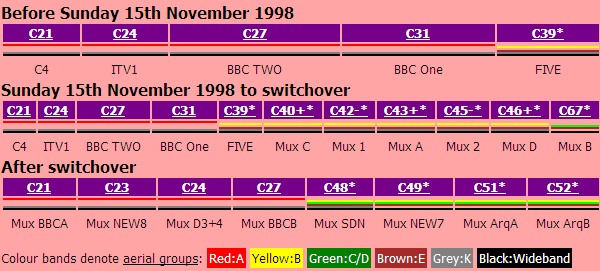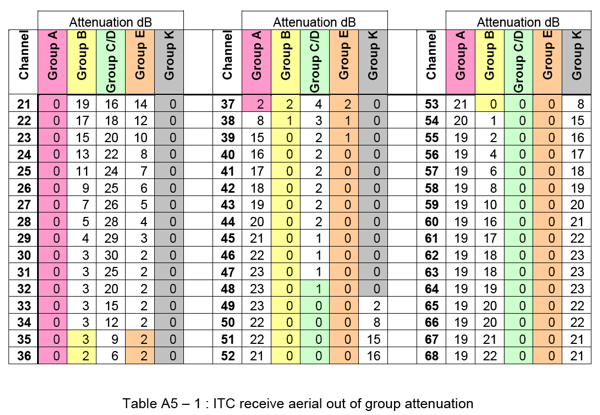Aerial groups - new feature
 Brian Butterworth published on UK Free TV
Brian Butterworth published on UK Free TV In the olden days of black and white, 405-line television, when the frequencies used were "very high" (VHF), the UK two-channel television service was provided using a just 100 transmitters and reception needed a standard aerial.
Later the system was upgraded to "ultra high frequencies" (UHF) for colour and now uses over 1,120 transmitters with more channels on more frequencies.
To enable the best quality reception possible, UHF television aerials are produced in a number of "groups". Each group is designed to operate on a range of channels, blocking all others. This is to prevent interference from "other" transmitters and to decrease losses on those required.
Each group is designated a colour, which is used to mark the aerial. Whilst wideband (black) aerials are designed to receive on all frequencies, their performance can be below a grouped aerial.
The transmitter pages now show a table like this:

The three sections show the three phases. The first is that before digital TV was introduced. This example shows that a group A (red) aerial would have received the original four channels but a group K was required to also receive FIVE. The channel number for FIVE on analogue is shown with an asterisk because it is "out of designated group", group A.
The second section shows the "digital with analogue" phase, where the transmitter has the analogue services from above with the new low power digital services. It can be clearly seen that on this transmitter a group A aerial will not receive any digital services at all, and that even a group K aerial will not receive the multiplex B service on C67. The only choice for digital reception here is a wideband (black) aerial because it is the only coloured band that crosses from left to right.
(You can also see that some of the digital services have plus and minus symbols. This indicates these transmissions use a 166.67kHz offset.)
The final section shows the designated frequencies that will be used for digital television after switchover. Whilst the public service multiplexes BBCA, BBCB, D3+4 are back "in group" (group A), to receive all the multiplexes, including the two potential new ones, the only choice here is wideband.
The performance of grouped aerials for each transmission channel was defined by the old Independent Television Commission (ITC) and is:

The larger the value, the lower the signal level possible.
6:12 PM
Does anybody know about the little red box at the bottom of analogue aerials? are they obtainable if damaged and do we actually need it?
| link to this comment |
David: OK, an aerial is an aerial is an aerial. They are not "analogue" or "digital".
There are plenty of things a "red box" could be, what is inside?
| link to this comment |
Hi Guys,
It might be a group a masthead, I seem to remember mastheads with group colours in the distant past ! if it is a group a masthead then yes they are still available but only in black !
Mark Aberfan Aerials
| link to this comment |
3:17 PM
Sheffield
Long time since I last posted on here. Back in March 2009 my problem (on the west side of Cambridge) was the MuxB/C67 signal from Sandy Heath, which was dreadful. Now, with a month or 2 to go until Sandy Heath cutover, C67 is the best and most reliable, and Mux 1/C42 and MuxC/C40 are the poorest, on a consistent basis; seems to me they've rearranged the transmitter in some way over the last year and a half. Ideas? Anyway, my real question was:- do I need to know about the +/- offset of some Muxes, as there doesn't seem to be any fine-tuning available on any freeview box I've ever owned?
| link to this comment |
Chrism's: mapC's Freeview map terrainC's terrain plot wavesC's frequency data C's Freeview Detailed Coverage
Chrism: No, you don't need to use the offsets, your equipment will automatically check them.
| link to this comment |
10:49 PM
Belvedere
Can anyone help me please?
I have bought Sony tv with HD freeview but I can only get freeview channels and not HD channels when auto and manual tuning channel 30. I live in DA17 area so crystal palace mast. some freeview channels have poor signal but most are fine. Aerial is in my loft.
Can anyone help please?
| link to this comment |
John's: mapJ's Freeview map terrainJ's terrain plot wavesJ's frequency data J's Freeview Detailed Coverage
11:12 PM
Reading
John: Pre-switchover HD services are on C31. C30 will be used after switchover - that's currently Channel 4 analogue. You have a pretty good chance of getting HD services now, but not quite as good as the other multiplexes. If you're having trouble with some others, your TV may not be able to see the HD services.
Do check that there is a Freeview HD logo on the TV, and that the manual says it supports DVB-T2. If it just says 'HD Ready' you'll need an external Freeview HD decoder.
| link to this comment |
Mike's: mapM's Freeview map terrainM's terrain plot wavesM's frequency data M's Freeview Detailed Coverage
1:11 AM
Belvedere
Yes, it is HD Freeview TV with DVB-T2, and I cant get HD channels on 31.
What can I do please?
| link to this comment |
John's: mapJ's Freeview map terrainJ's terrain plot wavesJ's frequency data J's Freeview Detailed Coverage
7:10 PM
Edinburgh
Anybody any idea about Edinburgh? Blackhill or Craigkelly? Seems to depend on where you read it.
| link to this comment |
Andy's: mapA's Freeview map terrainA's terrain plot wavesA's frequency data A's Freeview Detailed Coverage